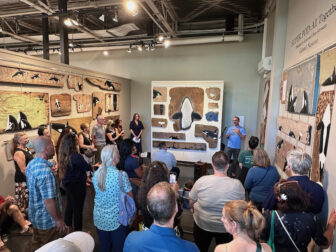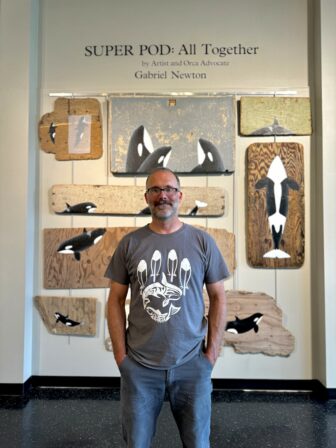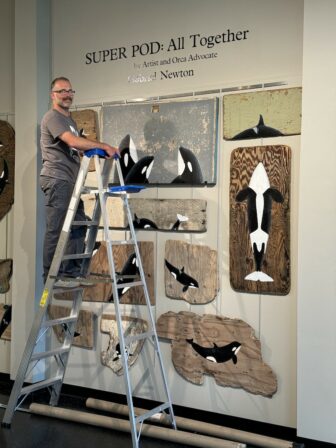The Pacific Northwest’s Salish Sea is home to many incredible creatures, but one of the most iconic is the Southern Resident Orca. The Southern Residents have experienced significant population declines beginning with the orca captures in the 1960s and 70’s, and were listed as Endangered under the Endangered Species Act in 2005. Lack of Chinook salmon – the primary source of food for the Southern Resident Orca, combined with noise pollution from vessel traffic and toxic pollutants in the Salish Sea have contributed to the decline of the Southern Residents. The Endangered Species Coalition has been a strong advocate for these orcas for years, working with Tribes and networks of organizations to promote science-based solutions, organize grassroots political support, and educate people on these issues.

We are excited to partner with artist Gabriel Newton on the SUPERPOD: All Together project this summer because it brings together two of our favorite things: the power of art as a culture change agent and collaborative grassroots activism. ESC prioritizes partnerships with creatives and leverages artistic expression to form connections and evoke emotions to spread awareness of threats our wildlife, plants, and ecosystems face.
The August 1st exhibit opening, with its evening of passionate speakers and an enthusiastic crowd, was a great way to kick off SUPERPOD’s display at A/NT Gallery on view through August 23rd Seeing all the remaining Southern Residents in one room through Newton’s paintings underscores the urgency for actions to protect the Southern Resident Orca and seeks to educate and inspire community members to support orca recovery, through actions like pressuring your elected officials to support Snake River Restoration by signing Newton’s petition, by reducing your energy use and installing solar panels, and using chemical free household products. Many people in the PNW have never seen the Southern Residents. This collection makes the Southern Residents more than numbers, allowing the viewer to connect with each of them and feel as if they are part of the pod.
Gabriel Newton is truly a fantastic example of an individual using their unique skills and passions to approach making change in the world. Learning about the Southern Residents’ precarious existence, Newton decided he needed to do something. He settled on using his art to spread awareness about the necessity of breaching the Lower Snake River Dams to increase the orcas main food source, Chinook/King Salmon.
Marin Plut, Endangered Species Coalition Intern, shares a conversation with Gabriel Newton about how he uses his artistic practice to inspire advocacy.

Marin Plut: You’re a big outdoorsman and world class kayaker. How did you get started as an artist and where do you see the intersections of these different aspects of who you are?
Gabriel Newton: I was fortunate to grow up with a grandmother who was a creative powerhouse, and a mother who encouraged my brothers and I to make our christmas gifts every year, so I had a lot of opportunities to exercise my creative capacity growing up. I explored many mediums, but it wasn’t until I settled with diachromatic paintings on found wood that I found my stride.
Having an artistic practice has encouraged me to pay closer attention when I am moving through the natural environment, and spending so much time in the wild has provided copious opportunities to observe wildlife for future incorporation into my paintings.
MP: Something unique about your paintings is that you use found driftwood as your canvas. Can you tell us a bit about how you discovered this practice and why it speaks to you?
GN: As my friends started to get married, I adopted a tradition of doing a pastel or painting as a wedding gift, and when my brother got married in 2010, I painted an abstract elephant lotus painting on a piece of found driftwood, and that soon became my primary medium. I like how the patterns in the wood grain complement the various animal forms, how the pieces of wood are sourced from the home of the orcas and other animals I paint, and that it feels like a collaboration with nature.
MP: SUPER POD features the endangered Southern Resident Orcas. What inspired you to paint them? What was your creative process like to paint all 74 remaining whales?
GN: After seeing the documentary Dammed to Extinction, I was trying to think of a creative way to raise more awareness of their plight. I settled on painting each individual whale so that it is easier to relate to them as individuals, and also see how few of them are left when they are all displayed in a single room. I painted many of them in familial groups so that people might consider their own family ties, highlighting how social orcas are and how much the loss of each orca must be felt by the survivors. In an effort to avoid redundancy, I decided to paint the orcas from as many different perspectives and in a wide variety of situations to honor the full breadth of their experience and expression.

MP: Orca and salmon advocacy is a big part of your life. Why should we all care about this issue and what are your recommendations for actions or changes that need to happen for their conservation?
GN: As a society, we have inadvertently threatened the existence of many species and the wellbeing of entire ecosystems by building dams anywhere and everywhere we possibly could. Rivers are the circulation system of the earth, and dammed rivers are much like clogged arteries. The detrimental effects of these dams will compound and adversely affect the wellbeing of everyone in this region for generations to come. The decline of orcas and salmon are just the most immediate and drastic effects of what will ripple out into the rest of our ecosystem. I suggest that people visit congressional offices to talk to a staff person, write a letter, make a call, or sign our petition. It also helps to put solar panels on your roof if you can!
MP: The name of the collection SUPER POD: All Together is inspired by the “super pod” events in which orcas come together in large social gatherings. How do you see your artwork engaging your audience and bringing people together? Why is this name important to the exhibit?
GN: The name is both literal, as all Southern Residents are represented, and symbolic, because it is going to take all of us to bring about the necessary changes for salmon and orca recovery. Political and social division is a common and detrimental aspect of our world today, and we are going to need to form a superpod in order to make the necessary changes!
MP: It’s so stunning to be in a room surrounded by all of the remaining Southern Residents. How do you feel about seeing all of the orcas up in the gallery room? How did people react to being immersed in the super pod?
GN: There is really something special about seeing them all together! There is this additive effect, where the different perspectives play off of each other, providing a composite impression of the Superpod. The feedback from people was really heartwarming. Many people had seen them online, but said that seeing them in person was so much more impactful.
MP: Is there anything further that you would like to add about SUPERPOD or orca conservation?
GN: I feel that it’s important to recognize that the indigenous tribes of this region have been working tirelessly for salmon and orca recovery for generations. They are the first and most ardent advocates of our beloved Southern Residents, and we should do everything we can to acknowledge and support their efforts! That is why 30% of all art proceeds will go to orca conservation at Sacred Sea.org, a Lummi led non-profit.
Come visit the exhibit is Seattle Center through August 23, with a Performance Night featuring live music, poetry, and play reading on August 22 from 6-8pm. The event is free and open to the public, RSVP here. You can take action for the Southern Residents by signing Newton’s petition to breach the Lower Snake River Dams here.
SUPERPOD: All Together is an exhibition and event series coordinated by Endangered Species Coalition, with support from Earth Ministry, Sierra Club, Northwest Artists Against Extinction, Se’Si’Le, and A/NT Gallery.
A/NT Gallery Seattle Center, exhibit free and open to the public August 1st-23rd, Performance Night August 22nd 6-8pm. More information at www.endangered.org/superpod.


1 comment on “SUPERPOD: All Together – an Interview with Artist Gabriel Newton”
What a wonderful person as exhibited by Gabe’s beautiful art.Thank you Gabe,from all who love the Ocean.Jeff Quam